Current Agriculture, Food & Resource Issues
D. Sparling and E. van Duren
Mart’s share of U.S. grocery retailing rose from zero in 1993 to 9 percent in 1998, with
total global supermarket category sales of approximately $39 billion annually. Food
retailers are using their customer and store bases to move into new areas, such as banking
and insurance, and even car sales.
Differentiated products can lead to new companies.
The preceding sections presented numerous examples of globalization and
concentration activities, evidence that could lead one to conclude that the process is a one-
way street, that firms have been disappearing and will continue to disappear as others
become larger and more global. While this is true in some industries, in others the number
of firms is actually increasing in spite of a multitude of mergers and acquisitions
(Ghemawat and Ghadar, 2000). As we will illustrate, the difference is frequently related
to the ability of the industry to differentiate its products.

□ Cash □ Stock □ Both □ Other (debenture)
Figure 10 Form of payment for reported transactions in the Canadian agri-food sector (only for those
transactions with recorded values)
Source: Annual Directory of Mergers and Acquisitions in Canada, 1996-2000
42
More intriguing information
1. Institutions, Social Norms, and Bargaining Power: An Analysis of Individual Leisure Time in Couple Households2. Spectral calibration of exponential Lévy Models [1]
3. Willingness-to-Pay for Energy Conservation and Free-Ridership on Subsidization – Evidence from Germany
4. The name is absent
5. The name is absent
6. Markets for Influence
7. Altruism with Social Roots: An Emerging Literature
8. Pass-through of external shocks along the pricing chain: A panel estimation approach for the euro area
9. Understanding the (relative) fall and rise of construction wages
10. A Unified Model For Developmental Robotics